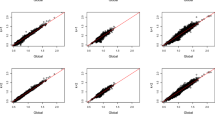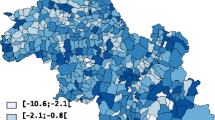Summary
In mapping geographical variation of risk or occurrence of disease in tract count data, information from the neighbouring areas is used to improve the estimate for a given area. However such information is incomplete for those areas at the region boundary and ignoring this could lead to a distortion of the estimates (edge-effect). We present a general approach to compensate for edge effects under a hierarchical Bayesian model. In our model the out-of-the-border areas are regarded as having missing values of the number of events but known population at risk. Two algorithms for the imputation of missing data and estimation of relative risks are applied: doubly stochastic EM and Chained Data Augmentation. Results on simulated data as well as a real example on mortality for gastric cancer in Tuscany (Italy) 1981–88 are discussed.
Similar content being viewed by others
References
Besag, J. (1974), Spatial interaction and statistical analysis of lattice systems.Journal of the Royal Statistical Society B, 36, 192–236.
Besag, J., York, J., Mollié, A. (1991), Bayesian image restoration, with application in spatial statistics (with discussion).Annals of the Institute of Statistical Mathematics, 43 (1), 1–59.
Best, N. G., Arnold, R. A., Thomas, A., Waller, L. A., Conlon, E. M. (1999), Bayesian models for spatially correlated disease and exposure data. InBayesian Statistics 6 (edited by José M. Bernardo, James O. Berger, A. Philip Dawid and Adrian F. M. Smith). Oxford: Oxford University Press.
Celeux, G., Diebolt, J. (1985), The SEM algorithm: a probabilistic teacher algorithm derived from the EM algorithm for the mixture problem.Computational Statistics Quarterly, 2, 73–82.
Cislaghi, C. et al. (1985),Atlas of cancer mortality in Italy. Bologna: Pitagora editore.
Dreassi, E., Biggeri, A. (1999), Edge effect in disease mapping. InAmerican Statistical Association 1999 Proceedings (of Biometrics Section), 111–116.
Gelman, A., Rubin, D. R. (1992), A single series from the Gibbs sampler provides a false sense of security. InBayesian Statistics 4 (Bernardo J. M., Berger J. O., Dawid A. P. and Smith A. F. M. Eds.), Oxford University Press, 169–193.
Geweke, J. (1992), Evaluating the accuracy of sampling-based approaches to the calculation of posterior moments. InBayesian Statistics 4 (Bernardo J. M., Berger J. O., Dawid A. P. and Smith A. F. M. Eds.), 625–631.
Gilks, W. R., Wild, P. (1992), Adaptive rejection sampling for Gibbs Sampling.Applied Statistics, 41 (2), 337–348.
Griffith, D. A. (1985), An evaluation of correction techniques for boundary effects in spatial analysis: contemporary methods.Geographical Analysis, 17, 81–88.
Griffith, D. A., Amrhein, C. G. (1983), An evaluation of correction techniques for boundary effects in spatial analysis: traditional methods.Geographical Analysis, 15, 352–360.
Griffith, D. A., Lagona, F. (1998), On the quality of likelihood-based estimators in spatial autoregressive models when the data dependence structure is misspecified.Journal of Statistical Planning and Inference, 69 (1), 153–174.
Lawson, A., Biggeri, A., Dreassi, E. (1999), Edge effects in disease mapping. InDisease Mapping and Risk Assessment for Public Health (Lawson A., Biggeri A., Böhning D., Lesaffre E., Viel J. F. and Bertollini R. Eds.), John Wiley & Sons, 85–98.
McLachlan, G. J., Krishnan, T. (1997),The EM algorithm and extensions. John Wiley & Sons.
Mollié, A., Richardson, S. (1991), Empirical Bayes estimates of cancer mortality rates using spatial models.Statistics in Medicine, 10, 95–112.
Spiegelhalter, D. J., Best, N. G., Carlin, B. P. (1998),Bayesian deviance, the effective number of parameters, and the comparison of arbitrarily complex models. Research Report 98-009, Division of Biostatistics, University of Minnesota.
Tanner, M. A., Wong, W. H. (1987), The calculation of posterior distributions by data augmentation.Journal of American Statistical Association, 82, 528–540.
Author information
Authors and Affiliations
Corresponding author
Rights and permissions
About this article
Cite this article
Dreassi, E., Biggeri, A. Edge effect in disease mapping. J. Ital. Statist. Soc. 7, 267 (1998). https://doi.org/10.1007/BF03178935
DOI: https://doi.org/10.1007/BF03178935




